24 - A First Flurry of Visitors
Saturday, September 29, 2012
September has always been my favourite month in Spain. Best temperatures, kids back at school, a bit less crowded on the beaches.
Still working through a diary full of random commitments in the UK, I could only find a 16-day window to be in Colmenar. But it was a packed 16 days! I had a hire car from the airport just for two days, while l picked up the Seat Ibiza from Antonio (the mechanic). The next day, Jenny and George from the U3A Poole Spanish conversation group completed the massive feat of driving over from their house in Valencia to visit me. They'd explored all their own area over the years and were venturing further afield. We had a lovely day, me showing off the delights of Colmenar including lunch at the Arco del Sol where Antonio (the bar) was delightful as ever and helped them improve their Spanish.
The next day, Gordon arrived and I did "the airport run" for the first time. The car behaved well and got us safely home at 2,400 feet (where Gordon, living in the Lake District at a mere 331 feet, was at risk of altitude sickness!). There was sightseeing to do, beginning with El Día de las Pasas, the Day of the Raisins, in the lakeside village of La Viñuela. We went for a lovely ramble out beyond the village, looking for where the raisins are laid out to dry. Didn't find them but the walk was well worth doing just for the scenery.
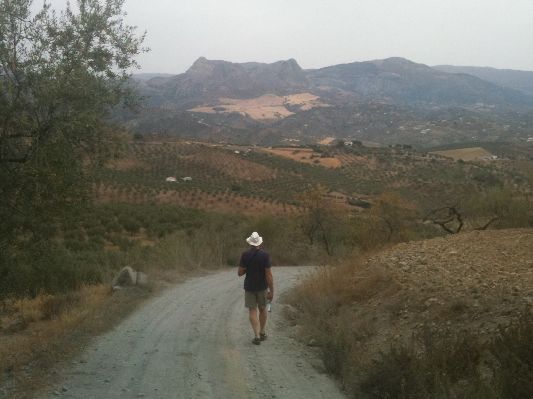 Gordon paid his "rent" by making his quota of papier-mache briquettes to add to my winter fuel supply, while also managing to find inspiration on the middle terrace to unblock a problem in his current novel. We took advantage of a slightly cloudy day to walk down to Riogordo, and enjoyed the landscape so much that we turned it into a big circular walk and climbed all the way back up to Colmenar. A walk that needs to be done monthly, to watch the changing seasons in the campo. Plus we squeezed in a trip to the coast, the main purpose of which was lunch at Torre Del Mar's best chiringuito (beach restaurant), but which did enable me to buy duvets for the cooler nights in October. One day Marianne and Michael from Cómpeta visited. Marianne is a fellow Axarquía blogger and sets the monthly photo challenge that l take part in. It was great to put faces to the names, and they too enjoyed Antonio's hospitality at Arco del Sol. Gordon paid his "rent" by making his quota of papier-mache briquettes to add to my winter fuel supply, while also managing to find inspiration on the middle terrace to unblock a problem in his current novel. We took advantage of a slightly cloudy day to walk down to Riogordo, and enjoyed the landscape so much that we turned it into a big circular walk and climbed all the way back up to Colmenar. A walk that needs to be done monthly, to watch the changing seasons in the campo. Plus we squeezed in a trip to the coast, the main purpose of which was lunch at Torre Del Mar's best chiringuito (beach restaurant), but which did enable me to buy duvets for the cooler nights in October. One day Marianne and Michael from Cómpeta visited. Marianne is a fellow Axarquía blogger and sets the monthly photo challenge that l take part in. It was great to put faces to the names, and they too enjoyed Antonio's hospitality at Arco del Sol.
Gordon's visit seemed all too short. He finished his visit by treating me to a superb lunch at Pilar's where we over-indulged on bison steak and oxen. Antonio (the mechanic) delivered the car to us at Pilar's having successfully got it through its ITV test (MOT-equivalent) just in time to take Gordon back to the airport.
 Only a couple of days without guests, so with the sheets washed and the fridge restocked, l took myself off to Casabermeja for the goat festival (see blog post 22). Some of the Riogordo women came over to Colmenar having leafletted the village dog show with fliers for their country fair and dog show later in the month and we met up for a coffee. Only a couple of days without guests, so with the sheets washed and the fridge restocked, l took myself off to Casabermeja for the goat festival (see blog post 22). Some of the Riogordo women came over to Colmenar having leafletted the village dog show with fliers for their country fair and dog show later in the month and we met up for a coffee.
And then it was time for the airport run again, this time to collect Sarah. Very bravely she had booked herself onto a 3-day intensive beginners' course in Spanish at Axalingua, the language school in Colmenar. After a windy first night she had a slightly chaotic first day as Telefónica came to repair my line (fortunately he said the problem was an old fixing, whereas l knew it was because l'd yanked it out rather too vigorously when squirting the ants behind it). Lunch at Arco del Sol seemed to make up for it, with Antonio feeding us well and being rather delighted with the number of different friends l was bringing to his restaurant!
 We had only one chance to go out in the car so decided to visit Benamargosa, and Su’s charming craft centre La Vaquería (the cowshed!). l then introduced Sarah to Bar CO2 so that she had somewhere to retreat for a beer after the stress of her language lessons. We had only one chance to go out in the car so decided to visit Benamargosa, and Su’s charming craft centre La Vaquería (the cowshed!). l then introduced Sarah to Bar CO2 so that she had somewhere to retreat for a beer after the stress of her language lessons.
Then with some final instructions to Sarah about closing windows and locking up, l left my little casita in her capable hands and took the Seat Ibiza down to the coast to park while l flew back to Dorset to fulfil a training commitment and see friends left behind. I didn’t realise I was leaving her to deal with the nearby storms and flooding, but fortunately Colmenar escaped the damage which so sadly affected villages only a little further north and west.
It was nice to have the house full, and it's nice when the visitors go away again! I like sharing it, and l value my time there alone. New routines are beginning to emerge, new networks are developing, and l'm exploring on foot and on four wheels the surrounding campo. I'm pleased to go back to Dorset and see friends, but the pull is strong ...... I need to spend more time in Spain.
© Tamara Essex 2012
 0
Like
Published at 8:24 PM Comments (2)
0
Like
Published at 8:24 PM Comments (2)
23 - Bricking It
Tuesday, September 25, 2012
My visitors don’t get a free ride, coming to stay with me. There’s rent to be paid. One brick, per person, per day. Simple.
My part in this is collecting lots of newspapers at every opportunity. Leftovers of the free papers, after they become “yesterday’s news”. Occasional bought newspapers. All heaped up in the storeroom awaiting the arrival of the next unsuspecting guest, who back in the UK had said “Gosh that sounds easy, yes of course we’ll make a load of papier-mache bricks for you Tamara”.
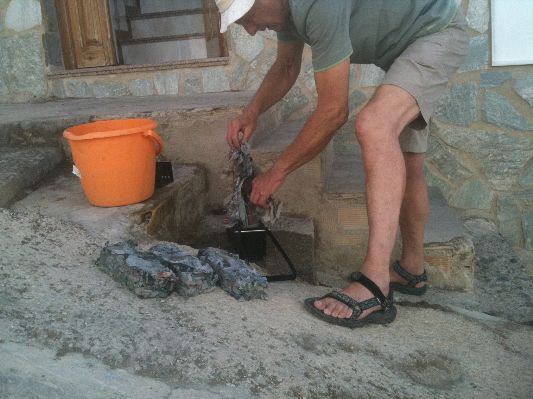 First task is the tearing into strips. About eight or ten newspapers at a time, torn lengthways into long strips. Easy, but quite tiring on the arm muscles after a while. These strips then need to be separated, draped across a bucket of water forming as intricate a web as possible, a sort of cat’s cradle, before they are pushed down into the water in gloopy batches. Nothing needs to be added, the recipe is solely newspaper and water. Two big bucket-loads are then left overnight to soak. First task is the tearing into strips. About eight or ten newspapers at a time, torn lengthways into long strips. Easy, but quite tiring on the arm muscles after a while. These strips then need to be separated, draped across a bucket of water forming as intricate a web as possible, a sort of cat’s cradle, before they are pushed down into the water in gloopy batches. Nothing needs to be added, the recipe is solely newspaper and water. Two big bucket-loads are then left overnight to soak.
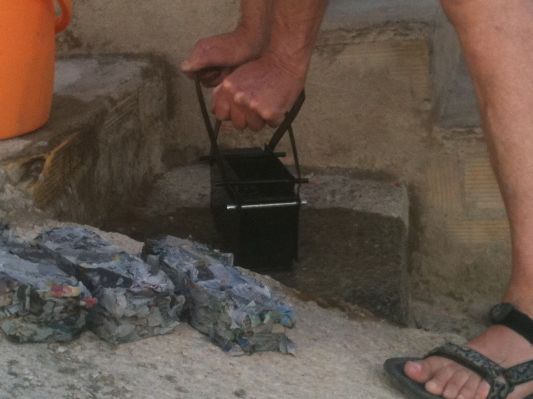 Next day, the heavy buckets are carried out to the street, along with the Green Eko-Log Machine. Handfuls of wet newspaper are glooped into the log-maker, the top press is fitted on, then it’s white-knuckle time as the water is squeezed out by sheer muscle-power. Out comes the top press, then carefully the compressed brick, log, or briquette, is lifted out and laid on the terrace to dry. Next day, the heavy buckets are carried out to the street, along with the Green Eko-Log Machine. Handfuls of wet newspaper are glooped into the log-maker, the top press is fitted on, then it’s white-knuckle time as the water is squeezed out by sheer muscle-power. Out comes the top press, then carefully the compressed brick, log, or briquette, is lifted out and laid on the terrace to dry.
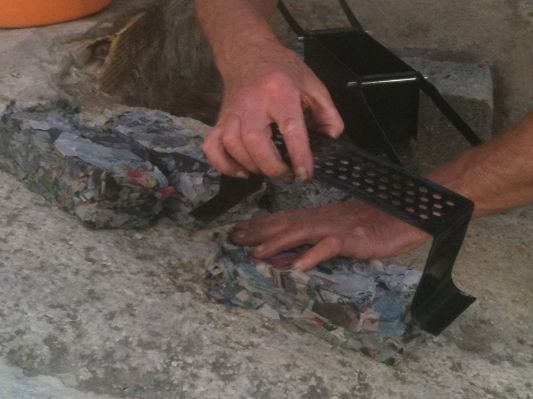 Twenty-four hours later, those briquettes are ready to be stacked in the storeroom. A new heap of newspapers glowers down from the shelf. The visitors pretend not to see these, deposit their dry briquettes and beat a hasty retreat, proud of the 6 or 7 bricks they’ve made, but not quite so keen to start all over again. Twenty-four hours later, those briquettes are ready to be stacked in the storeroom. A new heap of newspapers glowers down from the shelf. The visitors pretend not to see these, deposit their dry briquettes and beat a hasty retreat, proud of the 6 or 7 bricks they’ve made, but not quite so keen to start all over again.
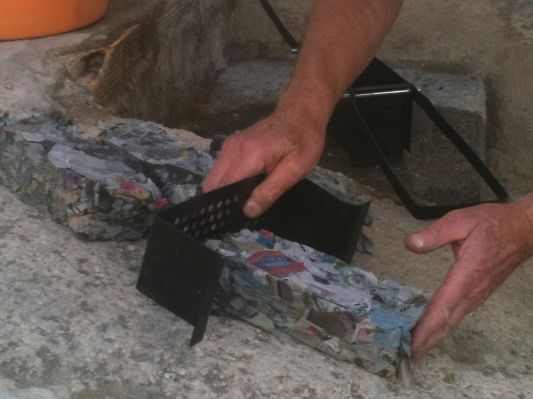 For me, every brick made is a log I won’t need to buy for the winter cold. Amazingly, these paper briquettes burn well and slowly, and will feed the woodburner (along with a large delivery of wood) until the sunshine returns to begin to dry out next season’s gloopy bricks. For me, every brick made is a log I won’t need to buy for the winter cold. Amazingly, these paper briquettes burn well and slowly, and will feed the woodburner (along with a large delivery of wood) until the sunshine returns to begin to dry out next season’s gloopy bricks.
© Tamara Essex 2012
 0
Like
Published at 11:22 AM Comments (6)
0
Like
Published at 11:22 AM Comments (6)
22 - Goats, Owls, and a Load of Tripe
Saturday, September 22, 2012
.JPG) Never let it be said that the humble goat has been left uncelebrated. In the Axarquía village of Casabermeja, the goat gets its own fiesta, and it’s not just a one day affair, but a full three days for this fine animal. Never let it be said that the humble goat has been left uncelebrated. In the Axarquía village of Casabermeja, the goat gets its own fiesta, and it’s not just a one day affair, but a full three days for this fine animal.
Falling into the old trap of imagining that an 11am start meant that it started at 11am (tschhhk, when will I learn?), I headed over to Casabermeja for around 2pm to find a few desultory stalls being built, some road closure signs stacked on the pavement, and nothing going on.
Parked by the Eastern Bazaar shop, my car was recognised. I was greeted as an old friend by Pedro, who runs the insurance office in Casabermeja. He is, naturally, a friend of Antonio who runs the insurance office in Colmenar. Moreover, Pedro’s son is a friend of Antonio the mechanic from whom I bought the car. This seemed to make me, too, a friend of Pedro. Did I mention Pedro’s son is called Antonio? Pedro and I chatted a bit about the fiesta and about the two villages, we agreed that people called Antonio are generally good types, and we parted on excellent terms. “Mi casa es tu casa”, he called as I left. “My house is your house”.
.JPG) Back at 9pm, Casabermeja was heaving with goat-related celebrations. A row of producers’ stalls offered an array of cheese, meats, honey, and crafts. The town band played while their mascot, dressed as a goat, wandered amongst the children, bizarrely allowing them to suck on his (her?) woolly teats. Back at 9pm, Casabermeja was heaving with goat-related celebrations. A row of producers’ stalls offered an array of cheese, meats, honey, and crafts. The town band played while their mascot, dressed as a goat, wandered amongst the children, bizarrely allowing them to suck on his (her?) woolly teats.
.JPG) Some real goats grazed amongst the crowd. One was tied up, in preparation for its big moment on stage for the speeches. I guess it had done the same job the year before, as just before it was due on stage it lifted a rear leg, expertly flicked its collar over its head, and legged it down the hill. The stallholder and I arced round in a pincer movement and forced the escapee into someone’s patio where it bit off a flower before being led back to the stage for its moment of glory. The owner turned out to be the founder of the goat festival and a man of high standing in goat circles. In thanks he forced a large packet of tripe on me (my reluctance had a massively sincere ring to it) before he too took to the stage for his big speech. A man in a wheelchair next to me told me I was lucky, it was award-winning tripe. I dumped it on him, muttered a lie about flying to England the next day, and legged it as fast as the goat. Some real goats grazed amongst the crowd. One was tied up, in preparation for its big moment on stage for the speeches. I guess it had done the same job the year before, as just before it was due on stage it lifted a rear leg, expertly flicked its collar over its head, and legged it down the hill. The stallholder and I arced round in a pincer movement and forced the escapee into someone’s patio where it bit off a flower before being led back to the stage for its moment of glory. The owner turned out to be the founder of the goat festival and a man of high standing in goat circles. In thanks he forced a large packet of tripe on me (my reluctance had a massively sincere ring to it) before he too took to the stage for his big speech. A man in a wheelchair next to me told me I was lucky, it was award-winning tripe. I dumped it on him, muttered a lie about flying to England the next day, and legged it as fast as the goat.
.JPG) Back in Colmenar, it was the weekend of the Hunting Dog Fair. I couldn’t see much activity other than a few stalls selling “outdoor pursuits” clothing and accessories, a taxidermist, and some owls on perches (live, fortunately). Outside opposite the donkey field row upon row of caged dogs were partially sheltered from the sun while their owners ensured that the beer tent at least would return home with a profit. Back in Colmenar, it was the weekend of the Hunting Dog Fair. I couldn’t see much activity other than a few stalls selling “outdoor pursuits” clothing and accessories, a taxidermist, and some owls on perches (live, fortunately). Outside opposite the donkey field row upon row of caged dogs were partially sheltered from the sun while their owners ensured that the beer tent at least would return home with a profit. .JPG) There didn’t seem to be a timetable for displays or activities, and I felt this was more of a trade fair and meeting point than a public event. I climbed to the summit of the donkey field and down the other side to the track that comes in from Riogordo, skirted round the edge of Colmenar and back home via the bakery for an apple pastry. There didn’t seem to be a timetable for displays or activities, and I felt this was more of a trade fair and meeting point than a public event. I climbed to the summit of the donkey field and down the other side to the track that comes in from Riogordo, skirted round the edge of Colmenar and back home via the bakery for an apple pastry.
© Tamara Essex 2012
 0
Like
Published at 9:51 PM Comments (4)
0
Like
Published at 9:51 PM Comments (4)
21 - Paper, Scissors, Stone
Friday, September 21, 2012
 I don’t think they’re doing it on purpose. It feels like they are, but I really truly don’t think they are. You must have experienced it? You pass a neighbor or a stranger in the street, you both nod, and you grunt out a greeting. “¡Hola!”, or perhaps “¡Buenos días!”, or sometimes just “¡Buenos!”. And whichever you pick, 99% of the time they reply with a different one. Why? I refuse to believe it’s some sort of contrariness! I don’t think they’re doing it on purpose. It feels like they are, but I really truly don’t think they are. You must have experienced it? You pass a neighbor or a stranger in the street, you both nod, and you grunt out a greeting. “¡Hola!”, or perhaps “¡Buenos días!”, or sometimes just “¡Buenos!”. And whichever you pick, 99% of the time they reply with a different one. Why? I refuse to believe it’s some sort of contrariness!
So maybe it’s a game? Maybe it is like paper, scissors, stone. But I don’t know the rules. I don’t know whether “¡Buenos días!” trumps “¡Hola!” or the other way round.
It’s a problem. My morning walk while the coffee is filtering, round the edge, look at the views down towards Riogordo, back past the panadería, and home with the bread, generally involves me having to choose which greeting to use about 12 – 15 times. I count it as a draw if “¡Buenos días!” is greeted with merely “¡Buenos!”. I lose if “¡Hola!” is returned with anything involving “¡Buenos!”, or viceversa. I win only if the reply is the same as my greeting.
I’m lucky to get back with the bread and a score of more than two.
© Tamara Essex 2012
 0
Like
Published at 2:06 PM Comments (18)
0
Like
Published at 2:06 PM Comments (18)
20 - Permission to Circulate, Sir!
Wednesday, September 19, 2012
Colmenar has a village population of well under 3,000 (with another 800 or so in the campo but on Colmenar’s register). There are 12,695 cars registered in Colmenar. Is there a course I’ve missed? The one where you sit in one car with the window open, leaning out to simultaneously drive your second car, while checking your third and fourth cars in the mirror as you drive off?
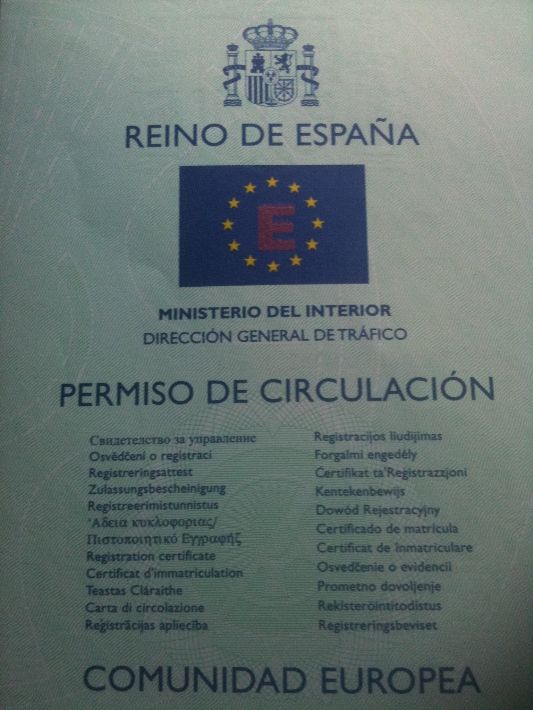 My favourite “possession” just at the moment is not my shiny new (old!) Seat Ibiza, but my “Permiso de Circulación” – permission to circulate! What a lovely concept. The Minister of the Interior has granted me, personally, permission to circulate throughout the Kingdom of Spain. I am thrilled with this, and plan to circulate a lot, waving my permission paper at anyone who asks (and many who don’t). My favourite “possession” just at the moment is not my shiny new (old!) Seat Ibiza, but my “Permiso de Circulación” – permission to circulate! What a lovely concept. The Minister of the Interior has granted me, personally, permission to circulate throughout the Kingdom of Spain. I am thrilled with this, and plan to circulate a lot, waving my permission paper at anyone who asks (and many who don’t).
It’s pretty much the equivalent of the road tax disc in the UK. Only in Spain it’s not paid centrally (there’s no equivalent to the DVLA, here). It’s paid locally within one’s municipality. Each municipality sets its own tax level (ie, the cost of the “Permiso de Circulación” ). And mine, Colmenar, happens to be particularly low. I have just paid for my first “Permiso de Circulación”, but it was in with various document transfers so I can’t be sure exactly how much was car tax and how much was admin and documents. But I’m reliably informed that elsewhere it costs significantly more.
So the clever car-hire companies in Málaga rent (or borrow) an office address in Colmenar, and register all their cars here. The ayuntamiento (town hall) doesn’t mind, as they gain the tax revenue, but don’t have the hassle of the cars being parked here. Seems like a win-win situation to me. I’m just dying to know whose bakery or village house is going to get all those renewal notices sticking out of their letterbox!
© Tamara Essex 2012
 0
Like
Published at 4:02 PM Comments (12)
0
Like
Published at 4:02 PM Comments (12)
19 - Defining "Home"
Monday, September 17, 2012
Well, blog number 7 “Going Home” http://bit.ly/Rf54ZP provoked a storm of debate on Eye on Spain www.eyeonspain.com where the different views of many ex-pats and extranjeros, part-time and full-time in Spain, weighed in with their fascinating perspectives on what defines “home”. Blog number 10 “Returning to Spain” http://bit.ly/QuE6yA described the impact watching the Olympics had on my perception of Britishness. Then, in Blog number 15 http://bit.ly/Pk42xx I wrote a bit about my mother and her extraordinary background of rootlessness, which may well have led to my ability to be “at home” pretty much anywhere.
Since then, and inspired by some of the comments on Eye on Spain, I have continued to listen in on conversations about “home” and to think about how people use the word. A fascinating conversation in a bar with a British couple who live six months in Cape Town and six months in Spain, led to a view that “Home is where you are”. But we then rapidly recognised that this cannot be the case for people trapped by circumstances such as work – or lack of it – in a place they don’t particularly want to be. Young people unable to move out of their parents’ house due to lack of work, a single mum stuck in a poorly-paid job away from family support, or ex-pats in Spain wanting to return to the UK but trapped by the property slump in Spain and by UK prices which are still higher than whatever they’ll get if they can sell their Spanish home.
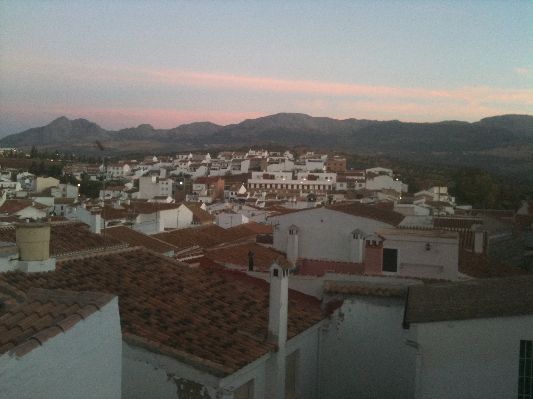 So the sentiment seemed right, but with the significant caveat that “Home is where you are” works only for people who have choices over where they are. Carole and Rob have not kept a base in the UK, and spend April to October in Spain and November to March in Cape Town. They are clear – both those places are home, and for them the UK is not home, but merely their homeland. So the sentiment seemed right, but with the significant caveat that “Home is where you are” works only for people who have choices over where they are. Carole and Rob have not kept a base in the UK, and spend April to October in Spain and November to March in Cape Town. They are clear – both those places are home, and for them the UK is not home, but merely their homeland.
Comments on Eye on Spain ranged from disgruntled ex-pats who wanted to return “home” to the UK but didn’t have a physical home there to go to, to contented ex-pats who have made their permanent home in Spain and have no desire to return to the UK. And a good smattering of every possible position in between! Louise suggested it is important to keep a base in the UK when moving to Spain. Sound advice, but not an option for everyone.
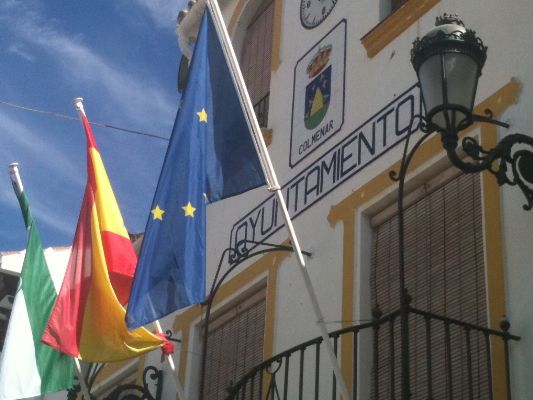 On such a small sample as those who commented on the Eye on Spain blog it is impossible to draw any statistically significant conclusions. But it seems fair to say that when first moving to a new country, it is sensible (if at all possible) to keep a base in the homeland, in case “living the dream” turns out to be just a fantasy once the August heat or the January freeze hits new residents who had only visited in the balmy months of May and September before. Not surprisingly, those who had learned the language to a reasonable level before taking the plunge also seemed more relaxed, and less angry about “Spanish bureaucracy” (a big bugbear on the Eye on Spain forums). One discussion on the forums focused on the question of how someone can really have all the information they need to function in another country if they don’t have the language to pick up the obvious and less obvious sources of information. On such a small sample as those who commented on the Eye on Spain blog it is impossible to draw any statistically significant conclusions. But it seems fair to say that when first moving to a new country, it is sensible (if at all possible) to keep a base in the homeland, in case “living the dream” turns out to be just a fantasy once the August heat or the January freeze hits new residents who had only visited in the balmy months of May and September before. Not surprisingly, those who had learned the language to a reasonable level before taking the plunge also seemed more relaxed, and less angry about “Spanish bureaucracy” (a big bugbear on the Eye on Spain forums). One discussion on the forums focused on the question of how someone can really have all the information they need to function in another country if they don’t have the language to pick up the obvious and less obvious sources of information.
It occurred to me that in the UK I have an automatic or instinctive understanding of when things are going well, or badly, for most of society or for an identified part of it. So during the Olympics there was an almost universal assumption that everyone on the train or in the supermarket queue had seen Mo Farah win the 5,000 metre race, and that everyone was delighted. When there is a very late, heavy cold snap there is an almost universal assumption that this will be bad for some harvest or other, and this can be brought up safely as a topic of sympathetic conversation at the farmers’ market. Do we have the equivalent understanding in our adopted country?
.JPG) This week my neighbor Rafael has been bringing home the sacks of almonds he has harvested, and his family has been sorting them into the high-quality heap and the medium-quality heap. My knowledge of the conditions required for a good almond harvest is non-existent. But he and his extended family make up most of my immediate neighbours, so a degree of understanding of whether it went badly or well for them is quite important. Without the language to ask him, I would have been left gesticulating, giving him the thumbs up because it looked like a lot of almonds to me, with no way of knowing whether it means that a newer car is imminent this autumn, or whether in fact the belts will be tightened instead. This week my neighbor Rafael has been bringing home the sacks of almonds he has harvested, and his family has been sorting them into the high-quality heap and the medium-quality heap. My knowledge of the conditions required for a good almond harvest is non-existent. But he and his extended family make up most of my immediate neighbours, so a degree of understanding of whether it went badly or well for them is quite important. Without the language to ask him, I would have been left gesticulating, giving him the thumbs up because it looked like a lot of almonds to me, with no way of knowing whether it means that a newer car is imminent this autumn, or whether in fact the belts will be tightened instead.
 The topic of home arose again amongst another group of friends, and this time the agreed definition was that “Home is where you feel you belong.” And following this thought came the recognition that someone living in more than one place is not rootless, but able to put roots down wherever they are. Not a skill everyone has. But this view makes it clearer that one can live in two countries and see them both equally as “home”. The topic of home arose again amongst another group of friends, and this time the agreed definition was that “Home is where you feel you belong.” And following this thought came the recognition that someone living in more than one place is not rootless, but able to put roots down wherever they are. Not a skill everyone has. But this view makes it clearer that one can live in two countries and see them both equally as “home”.
And finally, as one astute woman on Eye on Spain commented: “Some people just aren’t cut out for living in someone else’s country”. And each of us needs to look deep inside ourselves before making the move, to ensure we have what we will need - flexibility, resilience, a genuine interest in and respect for other cultures, an understanding that things can be done differently and that’s not a crisis or wrong, and the ability (and independence) to create a home wherever we are.
© Tamara Essex 2012
 0
Like
Published at 11:21 PM Comments (17)
0
Like
Published at 11:21 PM Comments (17)
18 - A Taste (or Two) of Honey
Thursday, September 13, 2012
Avocado honey? Sounds a bit odd. Is it honey mixed with avocado? Is it sweet or savoury? No that’s silly – it’s honey made from pollen collected largely from the blossom of avocado trees.
The point about avocado honey is that it boosts your iron levels. And as someone whose blood is occasionally deemed to be slightly too deficient in iron to be collected tor others to use, I felt mine needed a boost. I knew that honey was, in the general scheme of things, good for me. What I didn’t realise was that different honey is good for different bits of me.
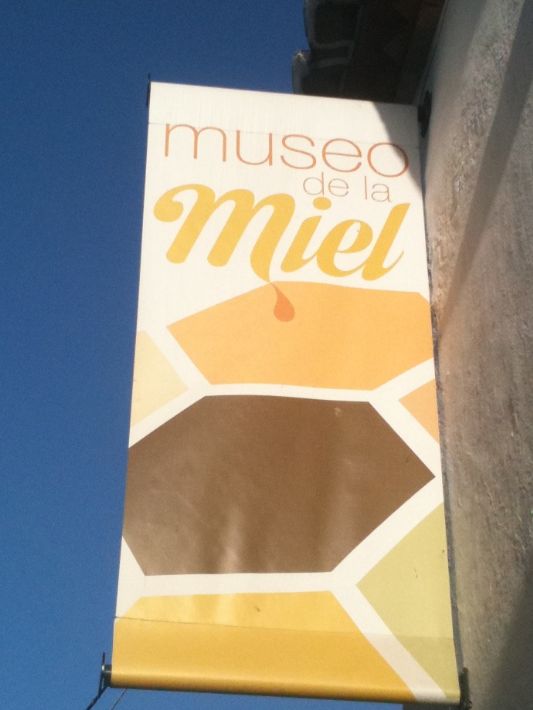 So I took myself off to El Museo de Miel in the next street along from mine. The Museum of Honey. Colmena means beehive, and Colmenar is the beehive of the Axarquía region. Thousands of acres of nut and fruit trees and acres of flowering herbs provide the perfect environment for the bees, and dozens of local producers combine into la asociación Malagueña de apicultores, the association of Málaga beekeepers, based here in Colmenar. The museum itself has wonderful displays, is very well-organised, and the film you watch can be played in Spanish, English or German. Over-60s get in very cheap – don’t forget to ask for your discount. So I took myself off to El Museo de Miel in the next street along from mine. The Museum of Honey. Colmena means beehive, and Colmenar is the beehive of the Axarquía region. Thousands of acres of nut and fruit trees and acres of flowering herbs provide the perfect environment for the bees, and dozens of local producers combine into la asociación Malagueña de apicultores, the association of Málaga beekeepers, based here in Colmenar. The museum itself has wonderful displays, is very well-organised, and the film you watch can be played in Spanish, English or German. Over-60s get in very cheap – don’t forget to ask for your discount.
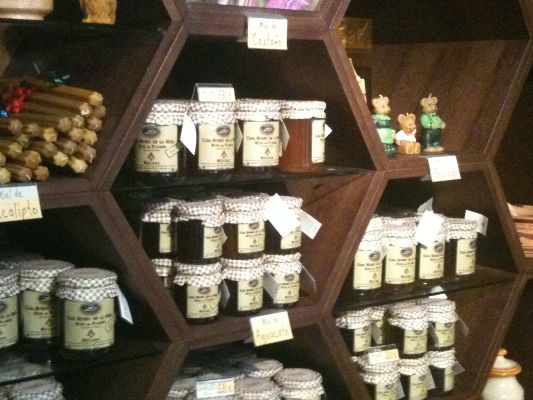 The shop at the honey museum is a monument to creativity – more things made of honey than you could ever have imagined. The honey sweets are delicious. The soap is beautifully scented and creamy and smells good enough to eat. There are candles and other beeswax products. Jars of pollen! But I’ve no idea what to do with it. The shop at the honey museum is a monument to creativity – more things made of honey than you could ever have imagined. The honey sweets are delicious. The soap is beautifully scented and creamy and smells good enough to eat. There are candles and other beeswax products. Jars of pollen! But I’ve no idea what to do with it.
And the tasting pots …… oh, those tasting pots! Little spatulas to try all the flavours – what a lovely way to waste half an hour!
Some of their claims for the medicinal benefits seem a little far-fetched, but even taken with a pinch of pollen they do give an indication of the type of ailment for which each honey is meant to be particularly effective.
Miel de Azahar – Orange-blossom honey. It has anti-spasm properties and is a soothing relaxant. Calms sleeping children and the elderly.
Miel de Romero – Rosemary honey. For heartburn, stomach ulcers, liver disease, cirrhosis, gout, epilepsy, rheumatism and dizziness. It counters physical and intellectual exhaustion.
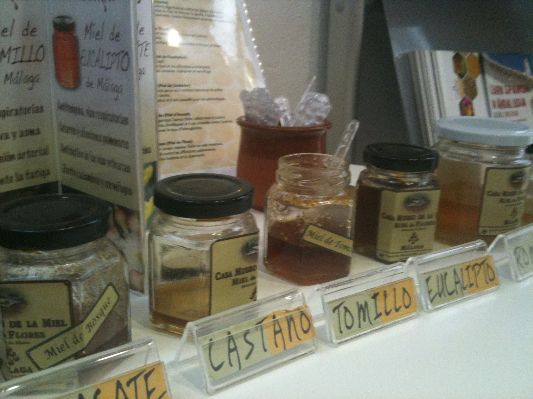 Miel de Tomillo – Thyme honey. For respiritory ailments, convulsive coughing and asthma. It regulates blood pressure and prevents fatigue. Miel de Tomillo – Thyme honey. For respiritory ailments, convulsive coughing and asthma. It regulates blood pressure and prevents fatigue.
Miel de Eucalipto – Eucalyptus honey. Effective against coughs, colds, urinary tract infections and intestinal worms. Clears airways.
Miel de Castaño – Chestnut honey. Rich in iron and tannins, good for circulation. Recommended for asthmatics. Strong taste.
Miel de Aguacate – Avocado blossom honey. Rich in organic iron. Prevents anaemia. Increases haemoglobin, and has diuretic properties. Strongly-flavoured, best used in cooking.
Miel de Bosque – Honey of the Forest. Rich in mineral salts, recommended for pulmonary infection, anaemia and dysentery. Dense flavour.
Miel de Milflores – Thousand-flower honey. An anti-inflammatory, helps digestion and healing, and increases energy and physical strength.
The honey museum has also given me a greater understanding of the campo that I walk through. As each type of tree or bush gives way to another, I try to identify them and the honey that the bees produce from them.
.JPG) In the end though, it’s not going to be about whether I feel especially gouty one morning, need to evict some intestinal worms or wish to calm a sleeping child (why would there be a need for that?), it’s going to be about the taste. I suppose I will work my way through them all in time, but so far I have tried only two - the Aguacate which may well have boosted my iron but which I found too strongly-flavoured for my taste, and the Milflores which is simply lovely. I’m not in immediate need of an anti-inflammatory, and I haven’t noticed an increase in physical strength, but it’s certainly yummy with a fresh bollo, a breakfast roll, and that’s what counts. In the end though, it’s not going to be about whether I feel especially gouty one morning, need to evict some intestinal worms or wish to calm a sleeping child (why would there be a need for that?), it’s going to be about the taste. I suppose I will work my way through them all in time, but so far I have tried only two - the Aguacate which may well have boosted my iron but which I found too strongly-flavoured for my taste, and the Milflores which is simply lovely. I’m not in immediate need of an anti-inflammatory, and I haven’t noticed an increase in physical strength, but it’s certainly yummy with a fresh bollo, a breakfast roll, and that’s what counts.
© Tamara Essex 2012
 0
Like
Published at 9:50 PM Comments (7)
0
Like
Published at 9:50 PM Comments (7)
17 - The Almond Harvest. Or: "Ways to Ensure Your Neighbours Think You're Mad number 67"
Tuesday, September 11, 2012
So Rafael has been working out in the campo, long hours, and finally it’s all paid off and he’s brought home the bacon. Or rather, he’s brought home the almonds. Thousands. Hundreds of thousands. And he appears to be storing them in his front room.
.JPG) He reckons he has several thousand trees. I think he had help picking them and loading them into the sacks. But once he’d brought them back to our little cul-de-sac he was on his own. The family two houses up the hill from me sat and drank and laughed and called out, making generally encouraging noises as Rafael heaved every single heavy sack out of the truck by himself. I leapt around asking naïve questions and generally getting in the way, but all the time providing enormous entertainment for the street. “You’ve never seen sacks of freshly-picked almonds before?” they asked, horrified. “What, you’ve never seen half a million almonds in a heap in somebody’s house before?” “So, in your country, where do people put the almonds when they’ve picked them?” Where, indeed. He reckons he has several thousand trees. I think he had help picking them and loading them into the sacks. But once he’d brought them back to our little cul-de-sac he was on his own. The family two houses up the hill from me sat and drank and laughed and called out, making generally encouraging noises as Rafael heaved every single heavy sack out of the truck by himself. I leapt around asking naïve questions and generally getting in the way, but all the time providing enormous entertainment for the street. “You’ve never seen sacks of freshly-picked almonds before?” they asked, horrified. “What, you’ve never seen half a million almonds in a heap in somebody’s house before?” “So, in your country, where do people put the almonds when they’ve picked them?” Where, indeed.
There’s a superb 8-second video on YouTube that shows an almond tree being harvested. It’s only 8 seconds because that’s how long it takes. http://www.youtube.com/watch?v=D7ymkfgqH3Y
Later, when I popped into the Arco del Sol bar a mile or so outside the village, they somehow already knew I’d asked questions about the almonds and taken pictures. Old men were chuckling on barstools, wondering why anyone would take pictures of something so mundane as a heap of almonds. They stared when I turned up. I was Exhibit A. They were delighted to see the actual foreign lunatic they’d been laughing about before I walked in.
.JPG) Rafael’s harvest will go mostly to be made into turron, the yummy nougat which floods the shops at Christmas time. The finest almonds will be taken to be put into bags of frutos secos (dried nuts and fruit). I can’t necessarily tell the difference between a merely average almond and a particularly fine one, but his harvest looks good to me. Even with the bicycles parked in it. Rafael’s harvest will go mostly to be made into turron, the yummy nougat which floods the shops at Christmas time. The finest almonds will be taken to be put into bags of frutos secos (dried nuts and fruit). I can’t necessarily tell the difference between a merely average almond and a particularly fine one, but his harvest looks good to me. Even with the bicycles parked in it.
© Tamara Essex 2012
 0
Like
Published at 12:51 AM Comments (3)
0
Like
Published at 12:51 AM Comments (3)
16 - Arriving Home
Monday, September 10, 2012
Arriving home. Saying it aloud makes it more real. Preparing for my first visitors. The wi-fi works (wouldn’t get any visitors without that – my friends are a high-tech bunch demanding good connectivity!). And there’s Spanish tv in the lounge, and English tv in my bedroom. Maybe I need to get Jose back to swap the cables round?
Arriving home. Hot water is working, the fridge is full of juice and the freezer is full of ice. Top up the tea bag pot with tea bags brought from England. The one thing everyone smuggles out here!
Arriving home, but still in a hire car. The mark of a visitor. All being well, I’ll get my own little Spanish car tomorrow or Tuesday. I’ll park it precariously on the narrow hill along with those of my neighbours. An ancient Seat Ibiza, scratched, with a sticker supporting Málaga football club, and something involving feathers and beads hanging from the mirror. Spanish newspaper on the back seat. The mark of a resident. It’ll blend in. It’s a local’s car, without the giveaway rental company’s sticker in the window.
Arriving home. Throwing open the shutters, opening my bedroom windows to that amazing mountain view – hidden now in the dark evening but ready to emerge in the morning. Not as hot as August, thank goodness. It’s Sunday night – some sounds from the street, not a lot. Sleep will come easily tonight.
© Tamara Essex 2012
 0
Like
Published at 1:56 AM Comments (4)
0
Like
Published at 1:56 AM Comments (4)
15 - A Child of the World
Monday, September 3, 2012
The discussions which arose from Blog numbers 7 & 10 about where “home” is and what makes it “home” have made me think a great deal about how and why it is that I can feel so quickly content almost anywhere. It made me think again about my mother’s extraordinary travel history, and wonder if I’ve inherited some sort of “travel gene” from her.
My mum’s mother had escaped the Russian Revolution as a child. Mum herself was born in 1930 in a village outside Danzig when it was a Free City-State, so in that sense she was truly a child of the whole world, not constrained by national boundaries.
When she was three the city’s government was taken over by the Nazi Party, and when she was eight the Free City was abolished and became part of West Prussia.
With her parents and her sister (my aunt, Tamara), she moved to Germany and settled in Dusseldorf. Life wasn’t smooth there – she spoke of the war very little but did tell of the time she watched terrified through the primary school window as Allied pilots strafed bullets at the younger children in the school playground. Undoubtedly the difficulties facing families during the war were no different in Germany than in England.
Aged 18, she left Germany and travelled by sea to Canada, and found a job and a flat in Toronto, and rapidly improving her English language skills. There, in 1950, a stunningly beautiful young woman, she met a young television editor called Tony Essex. They married in Toronto in December 1954, and the following year she became a citizen of the United Kingdom and Colonies, swearing the oath of allegiance to the High Commissioner of the United Kingdom in Ottawa. The certificate includes the line “I declare I am an alien …” – we can only hope things have moved on slightly since those days.
After a stay in New York, they sailed to England in 1956. We understand that she was already pregnant with my brother Peter and that some problem about a delayed sailing meant that he came quite close to being born an American citizen, but fortunately all worked out and they settled in Finchley safely in time for his birth as a British baby.
Mum definitely came from the generation that had to work hard for everything. They lived in a tiny upstairs flat where she had to carry Peter and his pushchair up several flights every day, and the first meal she cooked for my dad was boiled eggs cooked in a kettle because they didn’t have a saucepan. But she always described those days as the best of times – laughing together over her cooking disasters, scrimping and saving every penny, and having enormous fun.
Her second pregnancy, combined with dad’s increasing success as a highly-acclaimed producer at the BBC, led to their first house in Ealing. At last things became a bit easier for her – and fortunately both my brother and I were beautifully behaved and almost no trouble at all!
The travelling wasn’t over. In 1965 the family moved to Yorkshire where Dad was one of the founders of Yorkshire Television. Then in 1973 a bigger move – this time to Sydney, Australia, to make Dad’s next TV drama series. It was on their return to London in 1975 that my father died tragically early of a heart attack, leaving Mum widowed at just 44.
This led to a move to Buckinghamshire then quickly to Berkshire, where she buckled down to a secretarial course and began work at the German company AEG Telefunken. They undoubtedly expected her language skills to be of use to them, but the first time she was asked to speak to the German boss at head office in Berlin, she discovered she had forgotten every word of German and they had to send her on a beginners’ course!
It’s so easy for our generation – whichever generation – to imagine we are the ones with the exciting lives, we’re the ones doing it all, and we fondly imagine that our elders are watching from their rocking chairs, wishing they could travel and have such excitement. It’s rubbish, of course. If I live to be 100, I won’t pack into her life even a fraction of what my mother fitted into hers.
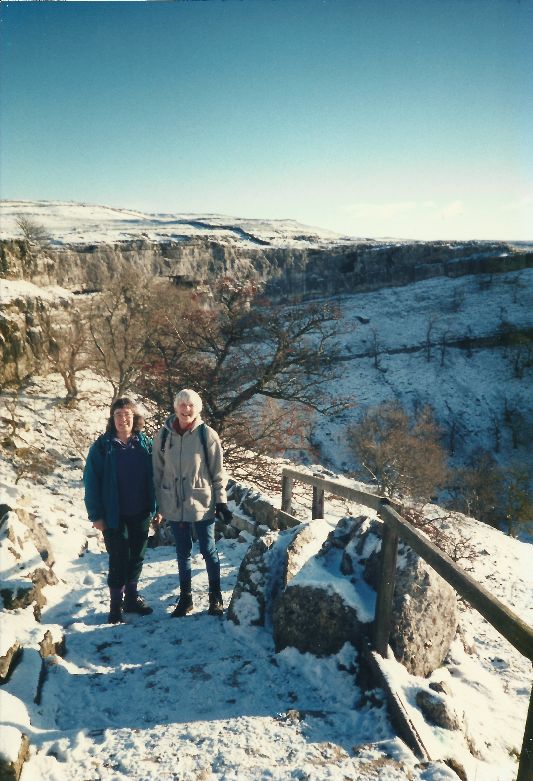 I’ve already described Mum’s extraordinary early years. In the 1980s and 90s a new kind of travelling began. Mum and I began a series of adventurous holidays together. We had begun in the 1970s by going off bed and breakfasting in every corner of England, Scotland and Wales, while Dad spent the weekends at our Yorkshire home writing and editing TV scripts. We never bothered to book accommodation, just set off with a map and a toothbrush to discover new counties. Now we looked further afield. I’ve already described Mum’s extraordinary early years. In the 1980s and 90s a new kind of travelling began. Mum and I began a series of adventurous holidays together. We had begun in the 1970s by going off bed and breakfasting in every corner of England, Scotland and Wales, while Dad spent the weekends at our Yorkshire home writing and editing TV scripts. We never bothered to book accommodation, just set off with a map and a toothbrush to discover new counties. Now we looked further afield.
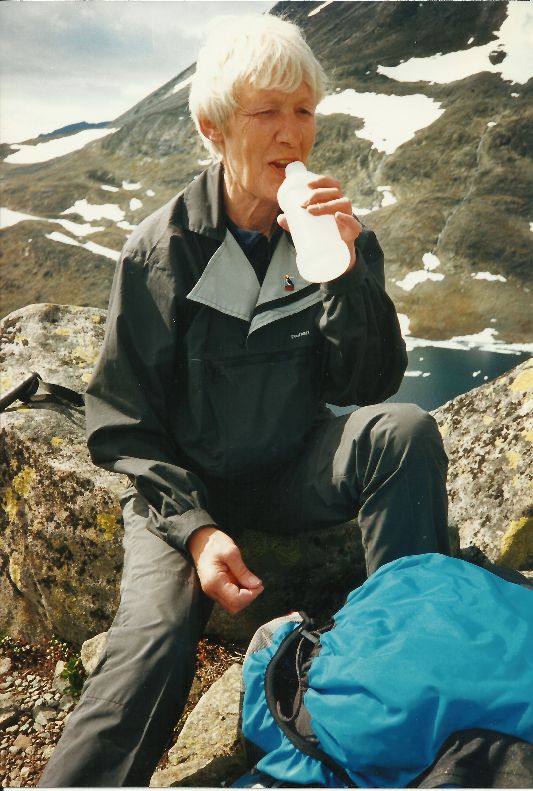 Together Mum and I visited Italy many times, France, and then an epic trip above the Arctic Circle through northern Norway – where exactly nineteen years before her death, Mum stood on the Norwegian border gazing into Russia, where her own mother had been born. Together Mum and I visited Italy many times, France, and then an epic trip above the Arctic Circle through northern Norway – where exactly nineteen years before her death, Mum stood on the Norwegian border gazing into Russia, where her own mother had been born.
She hadn’t lost her love of walking, and celebrated her 60th birthday by giving up smoking and walking the West Highland Way with me. In her last two months, when so many more recent memories were difficult to capture, any reminder of one of those holidays prompted a clear memory and details easily recalled.
In 2005 she moved to Shaftesbury to be near me. The walking trips were replaced with slightly more sedentary trips, exploring Dorset and discovering many wonderful pubs and tea shops. When she received her Disability Living Allowance, she re-named it her Disability Lunching Allowance. Being unconvinced that she really deserved it, she decided to spend it wisely on delicious pub lunches - with me as her more-than-willing chauffeur and companion.
Sunday was Scrabble day, when Mum and I would be locked in battle searching for the elusive 7-letter word. We each won about as many games as each other, until finally tiredness led Mum to push the board away unfinished during the last game we played together.
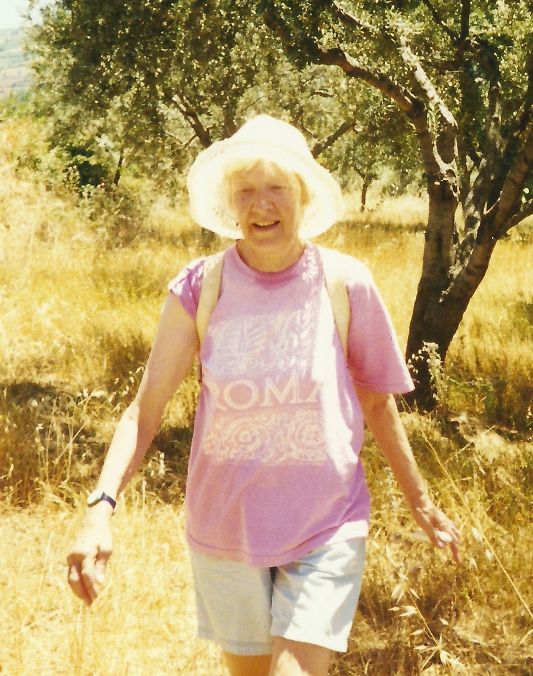 For me the days of lunch-trips and Scrabble seem very recent. Mum’s last year was difficult and painful, but borne with her trademark stoicism. Fortunately her final illness was short, and the exceptional care of the local GP practice and particularly the staff of Westminster Memorial Hospital in Shaftesbury kept her comfortable and free from pain until her death on June 4th this year. For me the days of lunch-trips and Scrabble seem very recent. Mum’s last year was difficult and painful, but borne with her trademark stoicism. Fortunately her final illness was short, and the exceptional care of the local GP practice and particularly the staff of Westminster Memorial Hospital in Shaftesbury kept her comfortable and free from pain until her death on June 4th this year.
It was a life full of extraordinary experiences, though she spoke very little of these. It was a life full of delight in the smallest things - like spitting cherrystones at the puffins on the Scilly Isles, the fresh crab sandwich served from a fisherman’s kitchen window on the Northumbrian coast, and picking a sun-warmed lemon from a tree in Southern Italy.
My mum - Ingrid Essex – born without nationality or boundaries. A traveller, a walker, and an inveterate luncher. A life lived to the full. A life well worth living.
© Tamara Essex 2012
 0
Like
Published at 2:20 PM Comments (4)
0
Like
Published at 2:20 PM Comments (4)
Spam post or Abuse? Please let us know
|
|